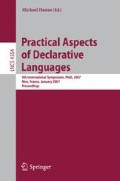Abstract
We describe a declarative language, called BAD (brain architecture description language), which we have developed for describing and then running brain models. Models are at the system-level of description, so that modules correspond to brain areas. Each module has a process and the set of modules runs in parallel and communicates via channels corresponding to observed brain connectivity. Processes are described using a parallel set of left-to-right first-order logical rules in clause form, but with additional activity in a rule body described by Prolog code. Data items are represented by logical literals. Both data and rules use certainty values. The overall system described by the user consists of more than one agent each controlled by a brain model, and behaving in a 3D virtual environment, which is described by logical literals. Interaction with this environment is described by Prolog code representing sensors and actuators. Brain models have been developed for social interaction, problem-solving, and episodic memory, routine memory and spatial working memory.
Access this chapter
Tax calculation will be finalised at checkout
Purchases are for personal use only
Preview
Unable to display preview. Download preview PDF.
References
Bond, A.H.: Describing Behavioral States using a System Model of the Primate Brain. American Journal of Primatology 49, 315–388 (1999)
Bond, A.H.: Modeling social relationship: An agent architecture for voluntary mutual control. In: Dautenhahn, K., Bond, A.H., Canamero, D., Edmonds, B. (eds.) Socially Intelligent Agents: Creating relationships with computers and robots, pp. 29–36. Kluwer Academic Publishers, Norwell (2002)
Bond, A.H.: Problem-solving behavior in a system model of the primate neocortex. Neurocomputing 44-46C, 735–742 (2002)
Bond, A.H.: A Computational Model for the Primate Neocortex based on its Functional Architecture. Journal of Theoretical Biology 227, 81–102 (2004)
Bond, A.H.: An Information-processing Analysis of the Functional Architecture of the Primate Neocortex. Journal of Theoretical Biology 227, 51–79 (2004)
Bond, A.H.: A psycholinguistically and neurolinguistically plausible system-level model of natural-language syntax processing. Neurocomputing 65-66, 833–841 (2005)
Bond, A.H.: Representing episodic memory in a system-level model of the brain. Neurocomputing 65–66, 261–273 (2005)
Bond, A.H.: A distributed modular logic programming model based on the cortex. In: Proceedings of the Workshop on Multivalued Programming Languages, Federated Logic Conference FloC-2006, Seattle (August 2006)
Bond, A.H.: A System-level Brain Model of Spatial working Memory. In: Proceedings of the 28th Annual Conference of the Cognitive Science Society, Vancouver, August, pp. 1026–1031 (2006)
Bond, A.H.: Brain mechanisms for interleaving routine and creative action. Neurocomputing 69, 1348–1353 (2006)
VanEmden, M.H., Kowalski, R.A.: The Semantics of Predicate Logic as a Programming Language. Journal of tbe Association for Computing Machinery 23, 733–742 (1976)
Author information
Authors and Affiliations
Editor information
Editors and Affiliations
Rights and permissions
Copyright information
© 2006 Springer-Verlag Berlin Heidelberg
About this paper
Cite this paper
Bond, A.H. (2006). BAD, a Declarative Logic-Based Language for Brain Modeling. In: Hanus, M. (eds) Practical Aspects of Declarative Languages. PADL 2007. Lecture Notes in Computer Science, vol 4354. Springer, Berlin, Heidelberg. https://doi.org/10.1007/978-3-540-69611-7_13
Download citation
DOI: https://doi.org/10.1007/978-3-540-69611-7_13
Publisher Name: Springer, Berlin, Heidelberg
Print ISBN: 978-3-540-69608-7
Online ISBN: 978-3-540-69611-7
eBook Packages: Computer ScienceComputer Science (R0)

